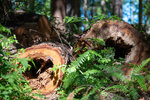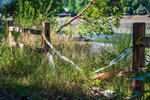

In 2018 the top broke off a tall Douglas fir and fell into YMCA Camp Seymour’s amphitheater, smashing several rows of benches and destroying the fire pit ring. No campers were present at the time.
The 100-foot tree left behind was cut down. The stump measured over three feet across, and the rings told a story. At just over 120 years old, it was a mere sapling when William Seymour donated the land to the YMCA in 1905.
The tree was removed along with hundreds of others in the heart of the camp in the final phase of a forestry effort that began in 2012. This summer, campers running the pathways between cabins and shoreline must contend with stumps, tread marks, and several piles of logs that could not be sold. About one-third of the area’s trees have been cut down.
The goal, according to camp director Scott Jackson, was to reduce hazards from diseased and leaning trees while maintaining the old growth forest character of the camp. “We’ve been dreading it for years,” he said.
“Mature trees tend to have health issues,” said forester Jaal Mann of Northwest Natural Resource Group, brought in to oversee the project. “There’s always going to be some rot, some branches falling off. That’s a natural part of a forest progression to an older stage. That’s not ideal when it’s around a bunch of buildings and children.”
Every tree within 200 feet of saltwater was numbered and evaluated by an arborist. The 30 or so trees that were obviously dangerous to Jackson and his staff turned into 300 trees beset by a number of problems, including laminated root rot, lean toward targets, beetle damage and heart rot. The majority were Douglas fir with about 40 cedars, 20 hemlocks and five madronas. They were a variety of heights and ages with the tallest firs reaching 200 feet and 57 inches in diameter.
“We didn’t want to cut in this area again, so if there was anything at risk, we came after it,” Jackson said.
“It devastated me,” said George Hovany, a neighbor and supporter of Camp Seymour. “I almost was crying the first time I walked through. But it’s a cancer and it has to be fixed. If you leave it go, it puts the children at risk, it puts the cabins at risk. Eventually those trees will come down on their own.”
Most forests in the area face similar health issues. Nearly all of Washington’s forests were once clearcut, and most were replanted with a single species, resulting in monocultures with low resistance to changing conditions. Laminated root rot in particular damages the trees in these monocultures. A native fungus that affects primarily middle-aged and older Douglas fir, it slowly creates pockets of trees with thinning canopies and signs of stress such as browning or excess cones. Allowed to spread, it will kill trees in a widening ring.
Mann said there are two primary ways to manage it. The first is to take out all diseased trees plus the next layer of healthy trees, which probably carry the fungus though they don’t yet show the signs, then replant with species such as native pines that are not susceptible. The second is to thin heavily around the pocket of laminated root rot in order to improve the general health of the trees left behind so that they can hold out longer against the fungus.
Most people think of Camp Seymour exclusively as a summer camp, said Ed Bressette, the longtime Camp Seymour facilities director and now director of facilities for YMCA of Pierce and Kitsap Counties, but for most of the year it is an environmental education destination, with school groups coming from all over Washington to learn about sustainability, marine biology and forest ecology.
“I feel as facilities director that we have to walk the talk,” he said.
Bressette was the driving force behind Camp Seymour’s forest management plan. The first two phases concentrated on thinning The Outback, a forest of dense second-growth Douglas fir where laminated root rot and competition between even-aged trees was taking a toll. “I wanted to develop the property to last another 100 years,” he said.
Prior to the thinning he would go outside during a storm and hear trees crashing to the ground throughout The Outback, competition having created trees that were too skinny for their height, unable to withstand moderate winds. By opening the forest canopy and introducing other species, the remaining firs can bulk into trees that might live for centuries.
“We call it the regrowth of an old growth forest,” Jackson said, “because we’re planting seedlings that we hope will live out their whole life here. That’s our goal.”
The forest is certified by the Forest Stewardship Council.
“We didn’t do any of this tree cutting for profit,” Bressette said. “There is no profit in logging unless you do a clearcut.” The first two phases made a small profit, which the camp used to buy seedling trees and maintain trails. In this latest phase, less than half of the logs were marketable, the majority being too diseased or full of old metal to send to a mill. The project cost over $300,000 net, triple the original budget.
In areas away from camp structures, the loggers left snags up to 70 feet tall as wildlife habitat. This winter the camp will purchase and plant 900 trees, diversifying the forest with cedar, native pines, vine and bigleaf maple, alder, willows and a variety of understory shrubs. Jackson plans to incorporate the planting days into programs for visiting students.
Following this final phase of active logging, the forest management plan calls for regular evaluations. Future logging projects should become less and less intensive as the forest takes on characteristics of old growth. “My whole thing is diversifying the forest to make it healthier,” said Bressette.
“Some of these things just take time,” said Mann. “You can take what would take 400 years naturally and help it happen in 200, but it’s still a time scale that’s beyond what most people are used to working in.”
For Mann, old growth is harder to define than it is to sense. He looks for a variety of tree sizes and ages, characteristic plants and flowers, mid-sized under-canopy trees, patches of disturbance with brush and young trees — and of course, big, ancient trees.
Bressette said that he is already starting to see in The Outback that the trees are growing out rather than up, their bark splitting as their trunks enlarge. He said that many of the students who visit during the school year have never been in a forest before. While to him this forest still looks young, to them the trees are bigger than they could have imagined.
“We look at laminated root rot as an agent of diversification in the forest,” said Mann. It creates standing dead trees, fallen wood, and areas of hardwoods, hemlocks, and cedars.
“Doug fir is a great tree for lumber production,” said Mann. “It grows really straight, it has a high value consistently, but diversity is important for disease resistance, for resistance to climate change and hot dry summers. Having a variety of tree species is definitely going to increase your odds that your forest will stay healthy and continue to thrive.”
UNDERWRITTEN BY THE FUND FOR NONPROFIT NEWS (NEWSMATCH) AT THE MIAMI FOUNDATION, THE ANGEL GUILD, ADVERTISERS, DONORS AND PEOPLE WHO SUPPORT INDEPENDENT, NONPROFIT LOCAL NEWS